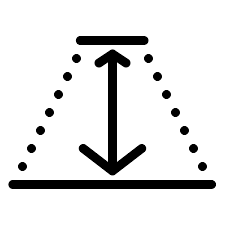The term “polymath” (wikipedia) may be new to you, but perhaps you have heard someone talk about people with a “T-shaped” set of skills. Both represent the idea of going deep in some spaces and broader in others. There are a few practices where going very deep with some skills is most ideal for quality performance and there are others that reward a jack of all trades. For the vast majority of situations it pays to be somewhere in-between.

This post is not about the concept of polymathism, but more about one way to achieve it and/or optimize it. The image of the hourglass is used to represent a waxing and a waning from a focus on a broad set of topics to deeply honing in on less.
As is often the case with the blog posts on this channel, they occur to me due to a confluence of ideas and/or activities to which I am exposed. In this case it is a connection of 3 different ideas
- I have been doing annual reviews for my direct reports at work. I meet with my reports every two weeks and aim to give them advice on their performance in each of those meetings. Additionally, an annual review forces a deeper reflection. As such, I have been contemplating learning and operating paths to success.
- I listened to a “PolyMathic Product Managers” presentation from Penny Szeto of Amazon at ProductCon
- I helped create a middle school math program that used technology to select which skill each student was going to work on each day. We had to take into account individual readiness and also cohort sub-groupings. We found that in order not to channel students, we needed a way for some students to go broad while the other students were catching up. That allowed them to all keep coming back together periodically. We called it the “Hourglass Progression”
After sitting down to write this post and doing a little interwebs research, I found that I was not the first to put “Polymath” and “Hourglass” together. David Miller talks about it in his post, “The Hourglass Analogy“. In that post he touches on the need for both deep AND wide. I aim to go a bit further.

My hypothesis is that the whole point of polymathism is to create variety and perspective. Thus, it is important to specifically alternate between deep and wide….essentially taking breaks between each deep dive in order to examine the world and all the connections that you might be able to make with the newfound deep knowledge. Essentially an application phase. This is the broad part of the hourglass.
Then, when the time is right, the sand accelerates into the narrow part of the hourglass and the person is learning something else deeply. Versatility is an important facet of a polymath, but a diverse team with a variety of backgrounds, skills, and viewpoints can accomplish that. What a team of individual experts is likely to struggle with that the polymath is well suited for is connecting ideas. Thus, shouldn’t we optimize for maximum connections? It seems to me, it is the alternating phases between the broadening and the deepening that will accomplish that goal.

In fact, I would encourage polymaths to actively capture their full set of interests and then after going deep on something (or during) to take some time out to do a “solo-roundtable” where you individually contemplate the connections between the new deep topic and each of the items on the list of broad topics. Are there opportunities in those connections that have not occured to you before?
If you seek to learn and operate as a polymath, do you have a process by which you select your goals? Do you follow the hourglass approach? How long do you spend in each of your deep phases? Has anyone tried this “solo-roundtable” to connect the deep part of the T to the arms?

